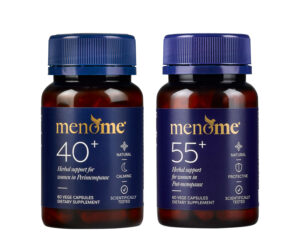Migraines and Perimenopause | Why You’ve Got A Headache

Perimenopause is the lead-up to menopause and the end of a woman’s fertility. Menopause itself is just one day, the last day of your last period and you only know it’s occurred when 12 months have passed. As a result, you have officially experienced menopause and are now post-menopause.
Migraines and perimenopause – why can headaches increase during the transition?
Hormonally speaking, women have had a long association with headaches and migraines triggered by hormone shifts. In fact, females are said to be 2:1 times more likely to experience a pain in the head than males.
One of the hallmarks of perimenopause, or the menopause transition, is a time of massive hormonal change. And because of this, one of the characteristic signs can be increased headaches/migraines.
“Unfortunately, many of the studies of migraine at menopause have included both post-menopausal and perimenopausal women. These two states have very different effects on hormonally sensitive migraine. One study did show that almost two-thirds of women with migraine experienced an improvement after menopause was established. And surgical menopause leads to abrupt changes in hormone levels and is likely to lead to an initial exacerbation of migraine. This may signify that there is an estrogen “threshold” below which migraine is triggered in sensitive women,” say The Australasian Menopause Society (AMS).
As most of us know, some women are more sensitive to their body’s nuances especially when it comes to hormones. So even if you’ve never had a problem with hormonal headaches in premenopause you could begin to feel migraine problems during perimenopause.
Similarly, if historically you’ve had issues with headaches around periods or ovulation you could find they become worse during perimenopause.
The good news is that once you’re through the menopause transition hormonal migraines and headaches may halt in post-menopause. Or at least improve.
What is the difference between a migraine and a headache?
The most common type of ‘standard’ headache is a tension headache.
Tension headache symptoms might include:
- Shoulder or neck tension
- Moderate pain in the head
- It’s dull and persistent
- Tightness or feeling like a tight band around the head
- A feeling of pressure
Migraines are categorised as a subtype of headache and they’re more debilitating than, say, a standard headache. There are actually three different types – migraine, aura migraine and vestibular migraine.
To put it simply an aura migraine is preceded by visual disturbances such as blind spots or flashing lights while a vestibular migraine may involve dizziness or balance issues.
NB: Aura migraine is associated with high estrogen (pregnancy, contraceptive pill) while migraine without aura is linked with low estrogen (peri/menopause)
Migraine symptoms may include:
- Irritability
- Increased yawning
- A sore neck
- Throbbing pain on one side of the head
- Sensitivity to light or sound
- Nausea
- Vomiting
Try Health Direct’s headache symptom checker here.
Are hormonal fluctuations behind migraines and perimenopause?
Not surprisingly the most common cause of hormonal headaches is shifting hormones and the unpredictable estrogen fluctuations of perimenopause.

As AMS stated above there are few studies of migraines in midlife women. However, clinical observation suggests they generally worsen during menopause and improve post-menopause. And if you’ve got a history of menstrual migraines you may be more susceptible to perimenopausal migraines. Source.
Researchers from the Women’s Headache Centre, the University of Turin in Italy state that “hormonal changes during the reproductive cycle are thought to account for the variation in migraine occurrence and intensity.”
They also note that many women experience migraine during perimenopause. “And if a woman already suffers from migraine, the attacks often worsen during the menopausal transition,” they say. “Initial onset of the condition during this period is relatively rare. Women with premenstrual syndrome (PMS) prior to entering menopause are more likely to experience, during the late menopausal transition, an increased prevalence of migraine attacks.
Indeed, the Department of Neurology at Harvard found that the overarching goal for treating migraine is the minimisation of estrogen fluctuations. Which creates the perfect platform for MenoMe® 40+ and 55+. The EstroG-100™ within the formulations is clinically proven to support balanced estrogen metabolism.
Migraines and perimenopause – do migraines or headaches decrease post-menopause?
Several studies show it’s the fluctuating estrogen of perimenopause that can bring on a migraine. Indeed, estrogen (or more specifically estradiol) goes through a rollercoaster of peaks and troughs during perimenopause. What’s more, perimenopause symptoms such as anxiety, depression and sleep disruption may also contribute.
And although every woman is different, for many women post-menopause brings relief from severe and frequent migraines and headaches.
What can you do to help minimise migraines and perimenopause?
1. Avoid triggers
Everyone’s triggers can be different but some of the more well-known things that can bring about migraines/headaches include:
- Caffeine
- Alcohol (especially red wine – sorry wine friends!)
- Some cheeses
- Dairy foods
- Chocolate (sorry!)
- Orange juice
- Monosodium glutimate (MSG)
- Sugar
- Stress
- Anxiety
Take a look at your food
Just as what you eat can play a big role in your peri/menopause journey likewise with hormonal headaches and migraines. As the above clearly shows.
It’s also important to keep your blood sugar stable by having lean proteins and healthy fats together and avoiding processed foods.
Another key point is to ensure you’re keeping well hydrated with filtered water.
Try keeping a diary to see if certain food groups trigger you.
NB: Some experts suggest that MHT/HRT and the contraceptive pill may trigger migraines/headaches. However, the opposite can be true or, in some cases, they may improve them. It depends on the individual.
2. De-stress
While we say this regularly, it’s especially true here. As a matter of fact, this study showed that stress might be behind 70% of migraines.
Although it should be noted that the study wasn’t done on women in midlife. However, it does show that stress plays a role so keeping the stress hormone cortisol on an even keel is key.
Or course, it can be a tall order to keep the stress monster at bay sometimes but there are simple things you can try. For example:
- Spend time with friends
- Go for a walk in nature
- Take an Epsom salt bath
- Have a massage
- Meditate
- Take up breath work
- Practise yoga
3. Exercise
Exercise for migraines is a bit of a paradox. On the one hand, exercise can be a recognised trigger for a migraine attack according to migrainetrust.org. On the other hand, they say moderate aerobic exercise such as walking or cycling has been found to reduce the frequency and improve symptoms. The Journal Of Headache and Pain say the role exercise plays in migraine prevention is unclear but it can have beneficial effects. “This is most likely due to an altered migraine triggering threshold in people who exercise regularly,” they say.
4. Take a look at Cognitive Behavioural Therapy
Cognitive Behavioural Therapy (CBT) is already well documented to be a great tool for women in menopause. Additionally, it’s been found to be helpful for the treatment of migraine and headaches. Based on the premise that how we think affects how we feel CBT leads to change in behaviour and effect. CBT uses relaxation strategies, stress management and teaches ways to cope with pain.
5. Try Biofeedback
Biofeedback trains a person to consciously control aspects of their physiology using strategies such as relaxation techniques. It’s often paired with CBT and together they can help to monitor your stress response.
6. Supplement
- MenoMe 40+ and 55+ (helps to minimise estrogen fluctuations)
- Magnesium (55+ contains magnesium)
- Vitamin D (55+ contains vitamin D3)
- Vitamin B2 (riboflavin)
- Coenzyme Q10
Migraines and perimenopause first aid
So you’ve been hit with a doozy, here are a few general things to try courtesy of Health Navigator:
- Drink a large glass of water.
- Take simple pain relief medication such as paracetamol, aspirin or ibuprofen. They may help ease tension headaches.
- For migraine medicines see your doctor.
- Use an ice pack wrapped in a towel or cold cloth on the painful area.
- Rest in a dark, quiet room.
- Have someone give you a head, neck and shoulder massage.
- Relax in a warm bath.
- Try some breathing exercises.
Conclusion
Perimenopause and migraines affect a lot of women and there’s no denying they’re not a walk in the park. However, although our knowledge is growing there is still not enough research available.
Consequently, more study is needed on migraines, headaches and midlife women. At this point, science points to the incidence of migraine increasing during perimenopause.
However, in this study, the prevalence of perimenopause seemed to correlate with those vulnerable to sensitive hormones such as those who had experienced premenstrual syndrome.
On the flip side of that, migraine appears to decline during natural post-menopause. And if menopause is due to surgery such as hysterectomy, migraines are related to a higher prevalence but they should settle down.
Disclaimer: Sometimes headaches/migraines can be indicative of other
issues. This is especially true if they come on suddenly or you feel
nauseous. Please see your medical professional.
Main photo: Ron Lach @Pexels











